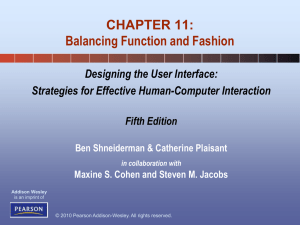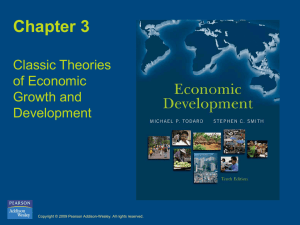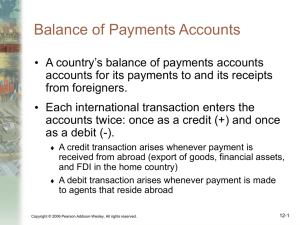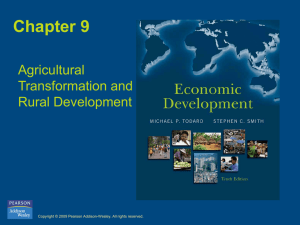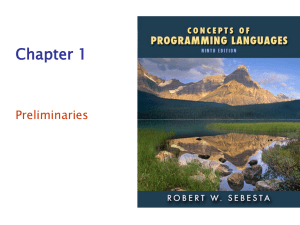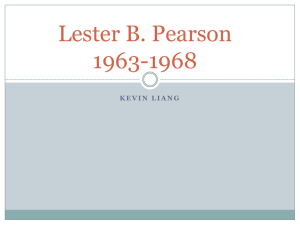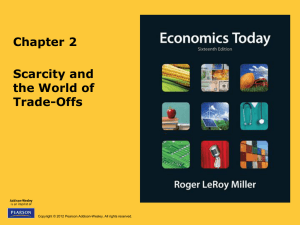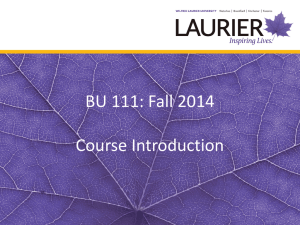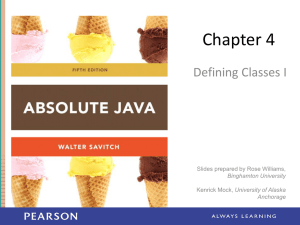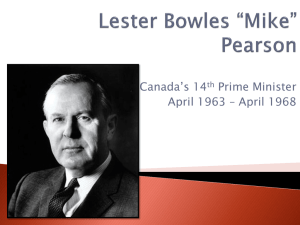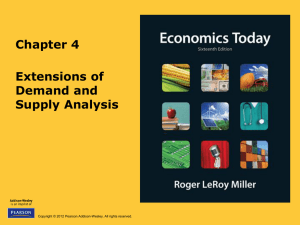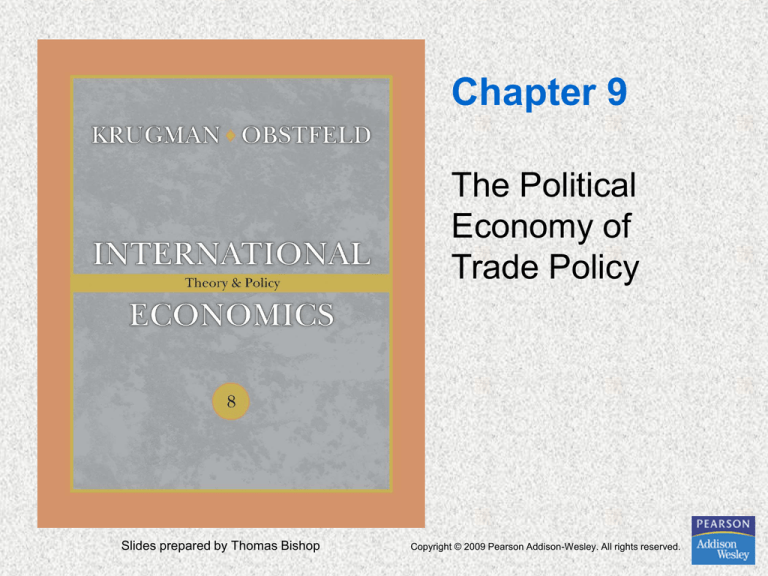
Chapter 9
The Political
Economy of
Trade Policy
Slides prepared by Thomas Bishop
Copyright © 2009 Pearson Addison-Wesley. All rights reserved.
Preview
• The cases for free trade
• The cases against free trade
• Political models of trade policy
• International negotiations of trade policy and
the World Trade Organization
Copyright © 2009 Pearson Addison-Wesley. All rights reserved.
9-2
The Cases for Free Trade
• The first case for free trade is the argument
that producers and consumers allocate
resources most efficiently when
governments do not distort market prices
through trade policy.
National welfare of a small country is highest with
free trade.
With restricted trade, consumers pay higher prices.
With restricted trade, distorted prices cause
overproduction either by existing firms producing
more or by more firms entering the industry.
Copyright © 2009 Pearson Addison-Wesley. All rights reserved.
9-3
Fig. 9-1: The Efficiency Case for Free
Trade
Copyright © 2009 Pearson Addison-Wesley. All rights reserved.
9-4
The Cases for Free Trade (cont.)
• However, because tariff rates are already low
for most countries, the estimated benefits of
moving to free trade are only a small fraction
of national income for most countries.
Copyright © 2009 Pearson Addison-Wesley. All rights reserved.
9-5
Table 9-1: Benefits of a Move to
Worldwide Free Trade (percent of GDP)
Copyright © 2009 Pearson Addison-Wesley. All rights reserved.
9-6
The Cases for Free Trade (cont.)
• Yet when quotas are used instead of tariffs,
costs can be magnified through rent seeking.
To seek quota licenses or the rights to sell a
restricted number of imports and the profit that
they will earn, individuals or institutions need to
spend time and other resources.
• Thus, another reason why trade allocates
resources efficiently is that it avoids the loss
of resources through rent seeking.
Copyright © 2009 Pearson Addison-Wesley. All rights reserved.
9-7
The Cases for Free Trade (cont.)
• A second argument for free trade is that it
allows firms or industry to take advantage of
economies of scale.
• A third argument for free trade is that it
provides competition and opportunities
for innovation.
• These are dynamic benefits, unlike the static
benefits of eliminating the efficiency losses
caused by distorted prices and overproduction.
Copyright © 2009 Pearson Addison-Wesley. All rights reserved.
9-8
The Cases for Free Trade (cont.)
• A fourth argument, called the political
argument for free trade, says that free trade
is the best feasible political policy, even
though there may be better policies in
principle.
Any policy that deviates from free trade would be
quickly manipulated by political groups, leading to
decreased national welfare.
Copyright © 2009 Pearson Addison-Wesley. All rights reserved.
9-9
The Cases Against Free Trade
• For a “large” country, a tariff or quota lowers
the price of imports in world markets and
generates a terms of trade gain.
This benefit may exceed the losses caused by
distortions in production and consumption.
• In fact, a small tariff will lead to an increase in
national welfare for a large country.
But at some tariff rate, the national welfare will
begin to decrease as the economic efficiency loss
exceeds the terms of trade gain.
Copyright © 2009 Pearson Addison-Wesley. All rights reserved.
9-10
Fig. 9-2: The Optimum Tariff
Copyright © 2009 Pearson Addison-Wesley. All rights reserved.
9-11
The Cases Against Free Trade (cont.)
• A tariff rate that completely prohibits imports
leaves a country worse off, but tariff rate t0
may exist that maximizes national welfare: an
optimum tariff.
Copyright © 2009 Pearson Addison-Wesley. All rights reserved.
9-12
The Cases Against Free Trade (cont.)
• An export tax (a negative export subsidy) that
completely prohibits exports leaves a country
worse off, but an export tax rate may exist that
maximizes national welfare through the terms
of trade.
An export subsidy lowers the terms of trade for a
large country; an export tax raises the terms of
trade for a large country.
An export tax may raise the price of exports in the
world market, increasing the terms of trade.
Copyright © 2009 Pearson Addison-Wesley. All rights reserved.
9-13
Counter-Argument
• For some countries like the U.S. an import
tariff or and export tax could improve national
welfare at the expense of other countries.
• But this argument ignores the likelihood that
other countries may retaliate against large
countries by enacting their own trade
restrictions.
Copyright © 2009 Pearson Addison-Wesley. All rights reserved.
9-14
The Cases Against Free Trade (cont.)
• A second argument against free trade is that
domestic market failures may exist that
cause free trade to be a suboptimal policy.
The economic efficiency loss calculations using
consumer and producer surplus assume that
markets function well.
Copyright © 2009 Pearson Addison-Wesley. All rights reserved.
9-15
The Cases Against Free Trade (cont.)
• Types of market failures include
Persistently high under-employment of workers
• surpluses that are not eliminated in the market for labor
because wages do not adjust
Persistently high under-utilization of structures, equipment
and other forms of capital
• surpluses that are not eliminated in the market for capital
because prices do not adjust
Technological benefits for society discovered through private
production, but from which private firms can not fully profit
Environmental costs for society caused by private production,
but for which private firms do not fully pay
Copyright © 2009 Pearson Addison-Wesley. All rights reserved.
9-16
The Cases Against Free Trade (cont.)
• Types of market failures include
property rights that are not well defined or well enforced
sellers that are not well informed about the (opportunity) cost
of production or buyers that are not well informed about value
from consumption
Copyright © 2009 Pearson Addison-Wesley. All rights reserved.
9-17
The Cases Against Free Trade (cont.)
• Economists calculate the marginal social
benefit to represent the additional benefit to
society from private production.
With a market failure, marginal social benefit is not
accurately measured by the producer surplus of
private firms, so that economic efficiency loss
calculations are misleading.
• It is possible that when a tariff increases
domestic production, the benefit to domestic
society will increase due to a market failure.
Copyright © 2009 Pearson Addison-Wesley. All rights reserved.
9-18
Fig. 9-3: The
Domestic Market
Failure
Argument for a
Tariff
Copyright © 2009 Pearson Addison-Wesley. All rights reserved.
9-19
The Cases Against Free Trade (cont.)
• The domestic market failure argument against free
trade is an example of a more general argument
called the theory of the second best.
• This theory states that government intervention which
distorts market incentives in one market may increase
national welfare by offsetting the consequences of
market failures elsewhere.
The best policy would be to fix the market failures
themselves, but if this is not feasible, then government
intervention in another market may the “second-best” way
of fixing the problem.
Copyright © 2009 Pearson Addison-Wesley. All rights reserved.
9-20
Counter-Arguments
• Economists supporting free trade counterargue that domestic market failures should be
corrected by a “first-best” policy: a domestic
policy aimed directly at the source of the
problem.
If persistently high under-employment of labor is a
problem, then the cost of labor or production of
labor-intensive products could be subsidized by
the government.
These subsidies could avoid the economic
efficiency losses due to a tariff.
Copyright © 2009 Pearson Addison-Wesley. All rights reserved.
9-21
Counter-Arguments (cont.)
• Because it is unclear when and to what degree a
market failure exists in the real world, it is unclear
when and to what degree government policies
should respond.
• Government policies to address market failures are
likely to be manipulated by politically powerful groups.
• Because it distorts the incentives of producers and
consumers, a trade policy may have unintended
consequences that make a situation worse, not better.
Copyright © 2009 Pearson Addison-Wesley. All rights reserved.
9-22
Political Models of Trade Policy
•
How is trade policy determined?
•
Models that address this question:
1. Median voter theorem
2. Collective action
3. A model of trade policy that combines aspects of
collective action and the median voter theorem
Copyright © 2009 Pearson Addison-Wesley. All rights reserved.
9-23
Median Voter Theorem
• The median voter theorem predicts that
democratic political parties may change their
policies to court the voter in the middle of the
ideological spectrum (i.e., the median voter).
• Suppose that this ideological spectrum is
defined only by a tariff rate policy.
And suppose that voters can be ranked according
to whether they desire high or low tariff rates.
Copyright © 2009 Pearson Addison-Wesley. All rights reserved.
9-24
Median Voter Theorem (cont.)
•
Assumptions of the model:
1. There are two competing political parties.
2. The objective of each party is to get elected by
majority vote (not to maintain ideological purity).
•
What policies will the parties promise to
follow?
Both parties will offer the same tariff policy to
court the median voter (the voter in the middle of
the spectrum) in order to capture the most votes
on either side of the median voter.
Copyright © 2009 Pearson Addison-Wesley. All rights reserved.
9-25
Fig. 9-4: Political Competition
Copyright © 2009 Pearson Addison-Wesley. All rights reserved.
9-26
Median Voter Theorem (cont.)
• Thus, the median voter theorem implies that a
two-party democracy should enact trade
policy based on how many voters it pleases.
A policy that inflicts large losses on a few people
(import-competing producers) but benefits a large
number of people (consumers) should be enacted
into law.
• But trade policy doesn’t seem to follow this
prediction.
Copyright © 2009 Pearson Addison-Wesley. All rights reserved.
9-27
Collective Action
• Political activity is often described as a
collective action problem:
While consumers as a group have an incentive to
advocate free trade, each individual consumer has
no incentive because his benefit is not large
compared to the cost and time required to
advocate free trade.
Policies that impose large losses for society as a
whole but small losses on each individual may
therefore not face strong opposition.
Copyright © 2009 Pearson Addison-Wesley. All rights reserved.
9-28
Collective Action (cont.)
• However, for those groups who may suffer
large losses from free trade (for example,
unemployment), each individual in that group
has a strong incentive to advocate the policy
he desires.
In this case, the cost and time required to advocate
restricted trade is small compared to the cost of
unemployment.
Copyright © 2009 Pearson Addison-Wesley. All rights reserved.
9-29
A Model of Trade Policy
• While politicians may win elections partly because
they advocate popular policies as implied by the
median voter theorem, they also require funds to
run campaigns.
• These funds may especially come from groups who
do not have a collective action problem and are
willing to advocate a special interest policy.
• Models of trade restriction policy try to measure the
trade off between the reduction in welfare of
constituents as a whole and the increase in campaign
contributions from special interests.
Copyright © 2009 Pearson Addison-Wesley. All rights reserved.
9-30
Which Industries Are Protected?
• Agriculture: in the U.S., Europe, and Japan
farmers make up a small fraction of the
electorate but receive generous subsidies and
trade protection.
Examples: European Union’s Common Agricultural
Policy, Japan’s 1000% tariff on imported rice,
America’s sugar quota.
Copyright © 2009 Pearson Addison-Wesley. All rights reserved.
9-31
Which Industries Are Protected? (cont.)
• Clothing: textiles (fabrication of cloth) and
apparel (assembly of cloth into clothing).
Until 2005, quotas licenses granted to textile and
apparel exporters were specified in the Multi-Fiber
Agreement between the U.S. and many other
nations.
Copyright © 2009 Pearson Addison-Wesley. All rights reserved.
9-32
Table 9-2: Welfare Costs of U.S.
Protection ($ billion)
Copyright © 2009 Pearson Addison-Wesley. All rights reserved.
9-33
International Negotiations of Trade Policy
• The average U.S. tariff rate on dutiable imports
has decreased substantially from 1920–1993.
• Since 1944, much of the reduction in tariffs and
other trade restrictions came about through
international negotiations.
The General Agreement of Tariffs and Trade was
begun in 1947 as a provisional international
agreement and was replaced by a more formal
international institution called the World Trade
Organization in 1995.
Copyright © 2009 Pearson Addison-Wesley. All rights reserved.
9-34
Fig. 9-5: The U.S. Tariff Rate
Copyright © 2009 Pearson Addison-Wesley. All rights reserved.
9-35
International Negotiations
of Trade Policy (cont.)
• Multilateral negotiations mobilize exporters to
support free trade if they believe export
markets will expand.
This support would be lacking in a unilateral push
for free trade.
This support counteracts the support for restricted
trade by import-competing groups.
Copyright © 2009 Pearson Addison-Wesley. All rights reserved.
9-36
International Negotiations
of Trade Policy (cont.)
• Multilateral negotiations also help avoid a trade
war between countries, where each country enacts
trade restrictions.
• A trade war could result if each country has a political
interest (due to political pressure) to protect domestic
producers, regardless of what other countries do.
All countries could enact trade restrictions, even if it is in the
interest of all countries to have free trade.
• Let’s use a simple example to illustrate this point.
Copyright © 2009 Pearson Addison-Wesley. All rights reserved.
9-37
International Negotiations of Trade Policy
(cont.)
EU
Free Trade
Free Trade
$10B
$10B
Protection
$20B
-$10B
Protection
-$10B
$20B
US
Copyright © 2009 Pearson Addison-Wesley. All rights reserved.
-$5B
-$5B
9-38
International Negotiations
of Trade Policy (cont.)
• In this simple example, each country acting
individually would be better off with protection,
but both would be better off if both chose free
trade.
• If Japan and the U.S. can establish a binding
agreement to maintain free trade, both can
avoid the temptation of protection and both
can be made better off.
Copyright © 2009 Pearson Addison-Wesley. All rights reserved.
9-39
World Trade Organization
•
The WTO negotiations addresses trade
restrictions in at least 3 ways:
1. Reduction of tariff rates through
multilateral negotiations.
2. Binding: a tariff is “bound” by having the
imposing country agree not to raise it in the
future.
Copyright © 2009 Pearson Addison-Wesley. All rights reserved.
9-40
World Trade Organization (cont.)
3. Prevention of non-tariff barriers: quotas
and export subsidies are changed to tariffs
because the costs of tariff protection are
more apparent.
Subsidies for agricultural exports are an
exception.
Exceptions are also allowed for “market
disruptions” caused by a surge in imports.
Copyright © 2009 Pearson Addison-Wesley. All rights reserved.
9-41
World Trade Organization (cont.)
• The World Trade Organization was founded in
1995 on a number of agreements
General Agreement on Tariffs and Trade: covers
trade in goods
General Agreement on Tariffs and Services: covers
trade in services (ex., insurance, consulting, legal
services, banking).
Agreement on Trade-Related Aspects of
Intellectual Property: covers international property
rights (ex., patents and copyrights).
Copyright © 2009 Pearson Addison-Wesley. All rights reserved.
9-42
World Trade Organization (cont.)
The dispute settlement procedure: a formal
procedure where countries in a trade dispute can
bring their case to a panel of WTO experts to rule
upon.
The cases are settled fairly quickly: even with
appeals the procedure is not supposed to last
more than 15 months.
The panel uses previous agreements by member
countries to decide which ones are breaking their
agreements.
Copyright © 2009 Pearson Addison-Wesley. All rights reserved.
9-43
World Trade Organization (cont.)
A country that refuses to adhere to the panel’s
decision may be punished by allowing other
countries to impose trade restrictions on its
exports.
Copyright © 2009 Pearson Addison-Wesley. All rights reserved.
9-44
World Trade Organization (cont.)
• The GATT/WTO multilateral negotiations,
ratified in 1994 (called the Uruguay Round),
agreed that all quantitative restrictions (ex.,
quotas) on trade in textiles and clothing as
previously specified in the Multi-Fiber Agreement
were to be eliminated by 2005.
• But as the restrictions were eliminated, China
had to reimpose quotas until 2011 due to
political pressure.
Copyright © 2009 Pearson Addison-Wesley. All rights reserved.
9-45
World Trade Organization (cont.)
• In 2001, a new round of negotiations
was started in Doha, Qatar, but these
negotiations have failed to produce an
agreement.
Most of the remaining forms of protection
are in agriculture, textiles and clothing—
industries that are politically active (see
“Collective Action” above).
Copyright © 2009 Pearson Addison-Wesley. All rights reserved.
9-46
Table 9-4: Percentage Distribution of
Potential Gains from Free Trade
Copyright © 2009 Pearson Addison-Wesley. All rights reserved.
9-47
Do Agricultural Subsidies in Rich
Countries Hurt Poor Countries?
• We learned in chapter 8 that subsidies lower the
world price of products because domestic producers
are enticed to produce more.
So why should poor countries want rich countries to remove
their agricultural subsidies?
The likely answer has to do with the desires of farmers in
poor countries who compete with farmers in rich countries.
Yet, urban residents and farmers who do not compete (ex.,
coffee farmers) actually benefit from the lower prices of
subsidized food on world markets.
• For example, because China imports a lot of food, it would be
hurt by the removal of agricultural subsidies in rich countries
(ex., the U.S. and Europe) according to the Doha negotiations.
Copyright © 2009 Pearson Addison-Wesley. All rights reserved.
9-48
Table 9-5: Percentage Gains in
Income under Two Doha Scenarios
Copyright © 2009 Pearson Addison-Wesley. All rights reserved.
9-49
Preferential Trading Agreements
• Preferential trading agreements are trade agreements
between countries in which they lower tariffs for each
other but not for the rest of the world.
• Under the WTO, such discriminatory trade policies
are generally not allowed:
Each country in the WTO promises that all countries will pay
tariffs no higher than the nation that pays the lowest: called
the “most favored nation” (MFN) principle.
An exception to this principle is allowed only if the lowest
tariff rate is set at zero.
Copyright © 2009 Pearson Addison-Wesley. All rights reserved.
9-50
Preferential Trading Agreements (cont.)
•
There are two types of preferential trading
agreements in which tariff rates are set at or
near zero:
1. A free trade area: an agreement that allows
free trade among members, but each
member can have its own trade policy
towards non-member countries
An example is the North America Free Trade
Agreement (NAFTA).
Copyright © 2009 Pearson Addison-Wesley. All rights reserved.
9-51
Preferential Trading Agreements (cont.)
2. A customs union: an agreement that allows
free trade among members and requires a
common external trade policy towards nonmember countries.
An example is the European Union.
Copyright © 2009 Pearson Addison-Wesley. All rights reserved.
9-52
Preferential Trading Agreements (cont.)
• Are preferential trading agreements
necessarily good for national welfare?
• No, it is possible that national welfare
decreases under a preferential trading
agreement.
• How? Rather than gaining tariff revenue from
inexpensive imports from world markets, a
country may import expensive products from
member countries but not gain any tariff
revenue.
Copyright © 2009 Pearson Addison-Wesley. All rights reserved.
9-53
Preferential Trading Agreements (cont.)
• Preferential trading agreements increase national
welfare when new trade is created, but not when
existing trade from the outside world is diverted to
trade with member countries.
• Trade creation
occurs when high cost domestic production is replaced by
low cost imports from other members.
• Trade diversion
occurs when low cost imports from non-members are
diverted to high cost imports from member nations.
Copyright © 2009 Pearson Addison-Wesley. All rights reserved.
9-54
Summary
1. The cases for free trade are that
It allows consumers and producers to allocate
their resources freely and efficiently, without
price distortions.
It may allow for economies of scale.
It increases competition and innovation.
2. The cases against free trade are that trade
restrictions may allow
terms of trade gains
a government to address a market failure when
better policies are not feasible
Copyright © 2009 Pearson Addison-Wesley. All rights reserved.
9-55
Summary (cont.)
3. Models of trade policy making consider
incentives to adopt popular policies as well
as incentives to adopt unpopular policies if
these policies are advocated by groups that
make political contributions.
4. Agricultural and clothing industries are the
most protected industries in many countries.
Copyright © 2009 Pearson Addison-Wesley. All rights reserved.
9-56
Summary (cont.)
5. Multilateral negotiations of free trade may mobilize
domestic political support for free trade, as well as
make countries agree not to engage in a trade war.
6. The WTO and its predecessor have reduced tariffs
substantially in the last 50 years, and the WTO has
a dispute settlement procedure for trade disputes.
7. A preferential trading agreement is beneficial for a
country if it creates new trade but is harmful if it
diverts existing trade to higher cost alternatives.
Copyright © 2009 Pearson Addison-Wesley. All rights reserved.
9-57
Additional Chapter Art
Copyright © 2009 Pearson Addison-Wesley. All rights reserved.
9-58
Table 9-3: The Problem of Trade Warfare
Copyright © 2009 Pearson Addison-Wesley. All rights reserved.
9-59
Fig. 9A-1: Effects of a Tariff on Prices
Copyright © 2009 Pearson Addison-Wesley. All rights reserved.
9-60
Fig. 9A-2: Welfare Effects of a Tariff
Copyright © 2009 Pearson Addison-Wesley. All rights reserved.
9-61


